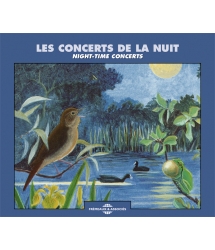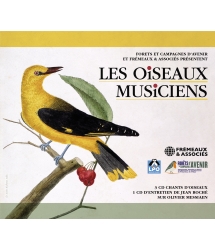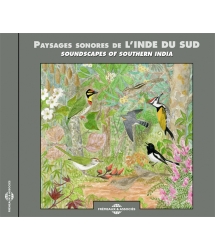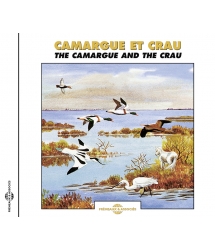- Our Catalog
- Philosophy
- Philosophers of the 20th century and today
- History of Philosophy (PUF)
- Counter-History and Brief Encyclopedia by Michel Onfray
- The philosophical work explained by Luc Ferry
- Ancient thought
- Thinkers of yesterday as seen by the philosophers of today
- Historical philosophical texts interpreted by great actors
- History
- Books (in French)
- Social science
- Historical words
- Audiobooks & Literature
- Our Catalog
- Jazz
- Blues
- Rock - Country - Cajun
- French song
- World music
- Africa
- France
- Québec / Canada
- Hawaï
- West Indies
- Caribbean
- Cuba & Afro-cubain
- Mexico
- South America
- Tango
- Brazil
- Tzigane / Gypsy
- Fado / Portugal
- Flamenco / Spain
- Yiddish / Israel
- China
- Tibet / Nepal
- Asia
- Indian Ocean / Madagascar
- Japan
- Indonesia
- Oceania
- India
- Bangladesh
- USSR / Communist songs
- World music / Miscellaneous
- Classical music
- Composers - Movie Soundtracks
- Sounds of nature
- Our Catalog
- Youth
- Philosophy
- News
- How to order ?
- Receive the catalog
- Manifesto
- Dictionnary











- Our Catalog
- Philosophy
- Philosophers of the 20th century and today
- History of Philosophy (PUF)
- Counter-History and Brief Encyclopedia by Michel Onfray
- The philosophical work explained by Luc Ferry
- Ancient thought
- Thinkers of yesterday as seen by the philosophers of today
- Historical philosophical texts interpreted by great actors
- History
- Books (in French)
- Social science
- Historical words
- Audiobooks & Literature
- Our Catalog
- Jazz
- Blues
- Rock - Country - Cajun
- French song
- World music
- Africa
- France
- Québec / Canada
- Hawaï
- West Indies
- Caribbean
- Cuba & Afro-cubain
- Mexico
- South America
- Tango
- Brazil
- Tzigane / Gypsy
- Fado / Portugal
- Flamenco / Spain
- Yiddish / Israel
- China
- Tibet / Nepal
- Asia
- Indian Ocean / Madagascar
- Japan
- Indonesia
- Oceania
- India
- Bangladesh
- USSR / Communist songs
- World music / Miscellaneous
- Classical music
- Composers - Movie Soundtracks
- Sounds of nature
- Our Catalog
- Youth
- Philosophy
- News
- How to order ?
- Receive the catalog
- Manifesto
- Dictionnary
DUSK CHORUSES - TROPICAL NATURE
Ref.: FA661
Artistic Direction : PIERRE HUGUET
Label : Frémeaux & Associés
Total duration of the pack : 1 hours 2 minutes
Nbre. CD : 1
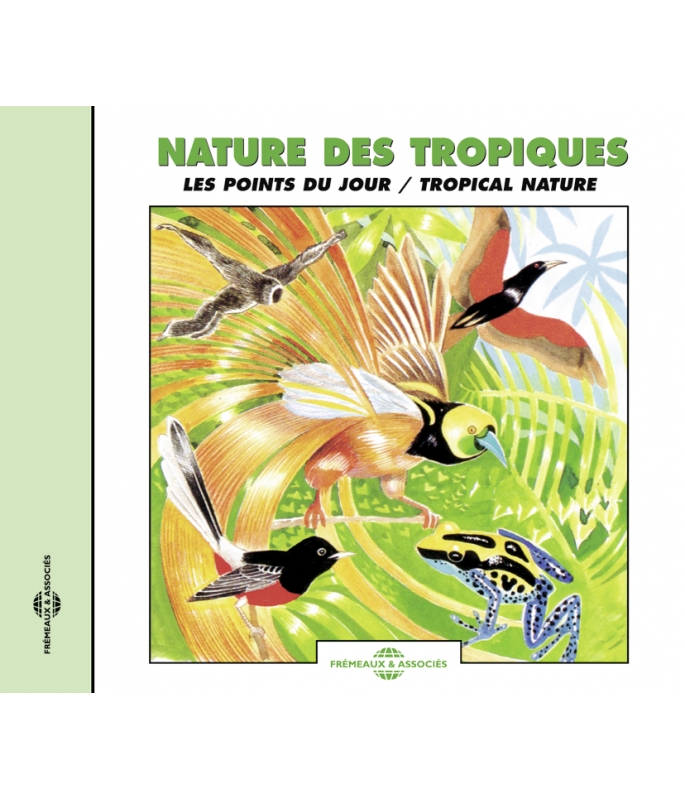
DUSK CHORUSES - TROPICAL NATURE
DUSK CHORUSES - TROPICAL NATURE
The world’s tropical habitats remained almost intact until the end of the 19th century. At that time they represented more than a third of the planet’s reserves of undeveloped land. What is more, these areas were so wild, so full of life, so inhospitable as to appear indestructible. Not so very long ago people referred to them as an impenetrable “green hell”. Today the entire tropical belt is under threat. This started with the arrival of the hevea plant but continues with forestry, the opening up of pasture for cattle, coffee and sugar cane plantations, not to mention mining. Nowhere has been spared: the forests of Amazonia, Africa and Asia are disappearing at a terrifying speed, taking with them complete ethnic groups, plant and animal species. Volume II of the “Dusk Choruses” series offers the listener a chance to hear various soundscapes from the areas under threat. All the recordings were made at locations, which at that time, could still be considered as “undisturbed”.
Pierre Huguet
Papouasie Nouvelle Guinée / Papua New Guinea • Zambie / Zambia • Madagascar / Madagascar • Malaisie / Malaysia • Congo / Congo • Guyane française - French Guiana • Pérou / Peru.
Audio rights FA661 EX PITHYS 0132 ou CD10132 : Frémeaux & Associés - La Librairie Sonore (Producteur initial : Pithys ou Sittelle ou Ceba) / Ecouter les chants d'oiseaux sur CD : Sons et ambiances naturelles des écosystèmes - Stéreo and digital recording of the natural landscape sound. Natural sound sceneries of écosystems, Voices of the Wild Life.
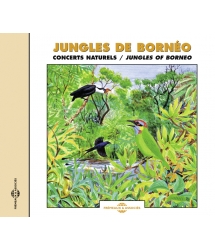
JUNGLES OF BORNEO
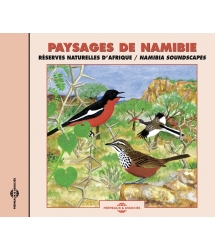
NAMIBIA SOUNDSCAPES
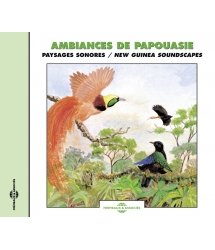
BIRDS OF PAPUA AND NEW GUINEA - NEW GUINEA...
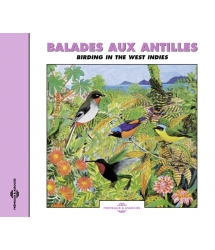
BIRDING IN THE WEST-INDIES




-
PisteTitleMain artistAutorDurationRegistered in
-
1Papouasie Nouvelle Guinée (1)00:04:051992
-
2Papouasie Nouvelle Guinée (2)00:05:411992
-
3Zambie (1)00:05:211992
-
4Zambie (2)00:05:011992
-
5Zambie (3)00:05:031992
-
6Madagascar00:05:561992
-
7Malaisie (1)00:06:111992
-
8Malaisie (2)00:03:271992
-
9Malaisie (3)00:05:061992
-
10Congo (1)00:05:001992
-
11Congo (2)00:03:581992
-
12Guyane Française00:02:531992
-
13Pérou00:04:251992
Tropical nature / Dusk Choruses
The world’s tropical habitats remained almost intact until the end of the 19th century. At that time they represented more than a third of the planet’s reserves of undeveloped land. What is more, these areas were so wild, so full of life, so inhospitable as to appear indestructible. Not so very long ago people referred to them as an impenetrable “green hell”. Today the entire tropical belt is under threat. This started with the arrival of the hevea plant but continues with forestry, the opening up of pasture for cattle, coffee and sugar cane plantations, not to mention mining. Nowhere has been spared: the forests of Amazonia, Africa and Asia are disappearing at a terrifying speed, taking with them complete ethnic groups, plant and animal species. Volume II of the “Dusk Choruses” series offers the listener a chance to hear various soundscapes from the areas under threat. All the recordings were made at locations, which at that time, could still be considered as “undisturbed”.
Pierre HUGUET
© 1992 Pithys - 2008 Frémeaux & Associés
Papua New Guinea
1 After a four day march, to the north west of Nomad, a flock of Common Piping Crows at the end of the day. About ten birds are audible. 4’05
2 Same location as track n° 1, but the next day just before sunrise; a single Common Piping Crow calls from time to time. The cry at the end of the sequence is a Raggiana Bird of Paradise. 5’41
Recording : November 1980. ADD.
Zambia
3 In the Luwangwa riverbed towards sunset a group of about thirty Hippo prepare to leave the water and feed in the cool of the night. Two Hadada Ibis fly past, uttering their characteristic, nasal cry. 5’21 - Recording : July 1986. ADD.
4 Not far from the Luwangwa night has almost fallen; a group of Baboons climb into the trees to sleep. Two large males dispute a perch. 5’01
5 - Zambia : Same location as track n° 4, but the next day; the Baboons are now on the ground, silent as they warm themselves in the morning sun. The recording is dominated by a Ring-necked Dove and a Sunbird. The slow sound of wings beating (after about 3 minutes) is produced by a southern Ground Hornbill. 5’03
Recording : July 1986. ADD.
Madagascar
6 There is a little reserve at Perinet, to the east of Tananarive, where one may observe Indri, the largest of the lemurs. Invariably the family (father, mother and offspring) are heard calling early in the morning, just after sunrise. 5’56 - Recording : September 1983. ADD.
Malaysia
7 On the edge of the Tembeling river, in the Taman Negara National Park at dawn; three White-rumped Shamas are disputing a patch of forest. 6’11
8 Kuala Atock in the Taman Negara National Park, in the early morning; mist condenses on the canopy turning into light rain as it reaches the ground. The grating of giant cicada is followed by a Gibbon singing. 3’28
9 Perkaï in the Taman Negara National Park, at sunrise; a pair of Greater Coucals execute a duet, whose dull melody echoes through the forest. 5’06 Recording : April 1989. DDD.
Congo
10 To the east of Ouesso, on either side of the Sangha river, the equatorial forest is dotted with swamps. The forest is almost impenetrable, which explains why some parts are still completely untouched (1990). Here, in the early morning a number of primates, including Chimpanzees, can be heard. Disturbed by an intruder they cry out threateningly, abandoning the nest they built for the night. 5’00
11 Same location as above, but at the end of a very stormy day; the birds seem to be taking advantage of a brief respite, before nightfall, to express their pent up feelings. 3’58 - Recording : January 1990, ADD.
French Guiana
12 In the far south of this region, close to the borders with Brazil and Surinam; night has almost fallen in the great Amazonian forest, and a storm is imminent. A strange sound rises from the water, a sort of dull hum; could it be a fish? In fact, it is a frog. 2’53 Recording : April 1988. ADD
Peru
13 In the north east of Peru, close to Lake Rimachi. Night has almost fallen over the flooded forest. The frog concert gradually rises above the insistent grating of the insects. 4’25 Recording : August 1976. ADD.
CD Nature des Tropiques © Frémeaux & Associés. Droits audio : Frémeaux & Associés - La Librairie Sonore (Producteur initial : Sittelle, Pithys, Collection Allain Bougrain Dubourg ou Ceba) / Ecouter les chants d'oiseaux sur CD : Sons et ambiances naturelles des écosystèmes - Stéreo and digital recording of the natural landscape sound. Natural sound sceneries of écosystems, Voices of the Wild Life. Les droits de cet enregistrement sont protégés par la loi. Pour toute exploitation d’illustration sonore sur CD, DVD, CD-Rom, Télévision, Cinéma, Sites internet, scénographies (théâtre, musées…), l’autorisation et un devis gratuit peuvent être obtenus auprès de Frémeaux & Associés – fax : +33 (0)1 43.65.24.22 info@fremeaux.com
